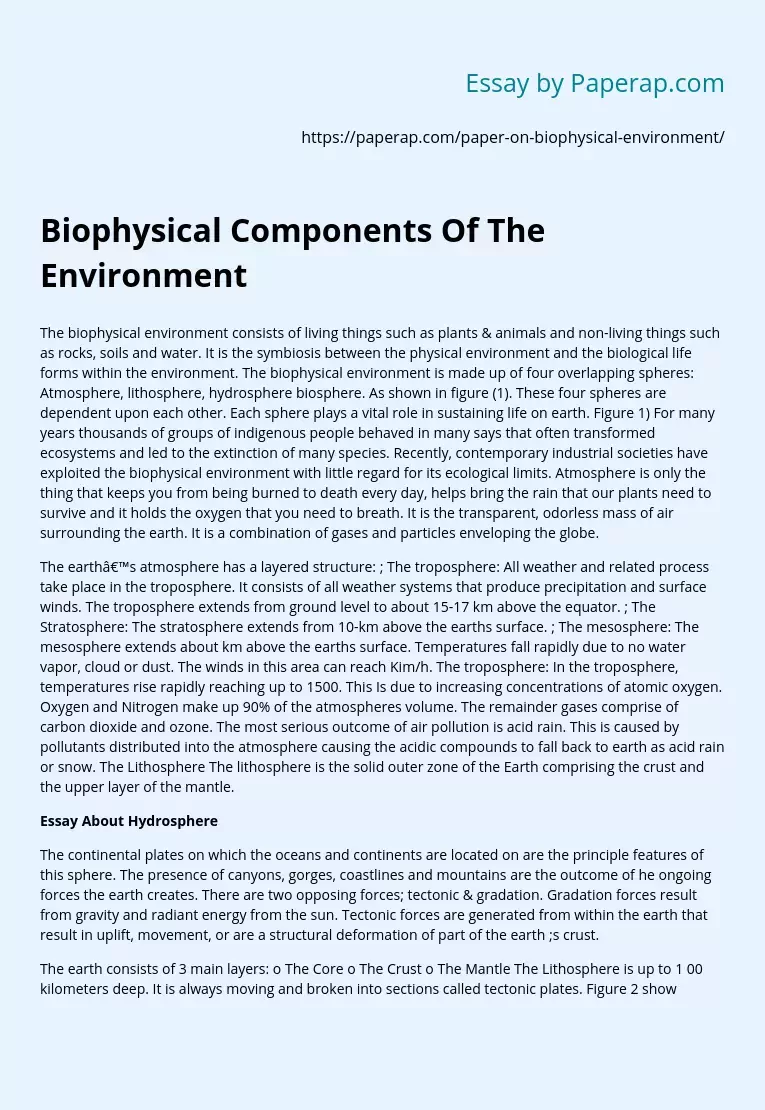Biophysical Components Of The Environment
The biophysical environment consists of living things such as plants & animals and non-living things such as rocks, soils and water. It is the symbiosis between the physical environment and the biological life forms within the environment. The biophysical environment is made up of four overlapping spheres: Atmosphere, lithosphere, hydrosphere biosphere. As shown in figure (1). These four spheres are dependent upon each other. Each sphere plays a vital role in sustaining life on earth. Figure 1) For many years thousands of groups of indigenous people behaved in many says that often transformed ecosystems and led to the extinction of many species.
Recently, contemporary industrial societies have exploited the biophysical environment with little regard for its ecological limits. Atmosphere is only the thing that keeps you from being burned to death every day, helps bring the rain that our plants need to survive and it holds the oxygen that you need to breath. It is the transparent, odorless mass of air surrounding the earth.
It is a combination of gases and particles enveloping the globe.
The earth’s atmosphere has a layered structure: ; The troposphere: All weather and related process take place in the troposphere. It consists of all weather systems that produce precipitation and surface winds. The troposphere extends from ground level to about 15-17 km above the equator. ; The Stratosphere: The stratosphere extends from 10-km above the earths surface. ; The mesosphere: The mesosphere extends about km above the earths surface. Temperatures fall rapidly due to no water vapor, cloud or dust.
The winds in this area can reach Kim/h. The troposphere: In the troposphere, temperatures rise rapidly reaching up to 1500. This Is due to increasing concentrations of atomic oxygen. Oxygen and Nitrogen make up 90% of the atmospheres volume. The remainder gases comprise of carbon dioxide and ozone. The most serious outcome of air pollution is acid rain. This is caused by pollutants distributed into the atmosphere causing the acidic compounds to fall back to earth as acid rain or snow. The Lithosphere The lithosphere is the solid outer zone of the Earth comprising the crust and the upper layer of the mantle.
Essay About Hydrosphere
The continental plates on which the oceans and continents are located on are the principle features of this sphere. The presence of canyons, gorges, coastlines and mountains are the outcome of he ongoing forces the earth creates. There are two opposing forces; tectonic & gradation. Gradation forces result from gravity and radiant energy from the sun. Tectonic forces are generated from within the earth that result in uplift, movement, or are a structural deformation of part of the earth ;s crust.
The earth consists of 3 main layers: o The Core o The Crust o The Mantle The Lithosphere is up to 1 00 kilometers deep. It is always moving and broken into sections called tectonic plates. Figure 2 shows the cross section of the earth that takes place in the Lithosphere. (Figure 2) The core is made up of molten rock. This is due to the intense heat it produces at the centre of the earth. It is made up of the inner and outer core. Inside the core the metals are constantly moving and rotating regularly. The mantle surrounds the inner core and is about Kim thick.
There is a soft layer of molten rock called the stratosphere. The stratosphere plays an important role in shaping the earth’s surface. The crust is the thinnest later of the earth. The crust of the Earth is broken into many pieces called plates. The Hydrosphere The hydrosphere is the liquid water component of the Earth. It includes: ; Oceans, ; Seas, ; Lakes, ; Ponds, ; Rivers Streams. The hydrosphere covers about 70% of the surface of the Earth and is the home for many plants and animals. Water is stored in a number of forms for varying periods of time.
Figure 2 shoes the sources of fresh water: ” Draw the circles” The same water has been circling the earth forever. No water is added and none is taken away, the only thing that changes is its geographical location. The cycle of water is shown below in Figure (3). “Draw the cycle?’ The Biosphere The biosphere is the layer of the planet Earth where life exists. It is the global realm that encompasses all living things from the creatures on the ocean lour and the insects. It includes all living organisms (biotic) and non-living organisms (biotic).
A community together with its non-living environment forms an ecosystem. Examples of ecosystems are: Pond o Forest o River o Grassland. Ecosystems can be divided into two groups: aquatic Ecosystems o Terrestrial Ecosystems Aquatic ecosystems include marine environments such as open sea, coral reefs and ocean inlets. Terrestrial ecosystems comprise of communities of plants and animals spread across the surface of continents. The Human impact I have chosen to discuss is the Human interactions with the hydrosphere.
Peoples activities have affected the hydrosphere in many ways: – reduced river flow – temperature change – isolation – pollution – overfeeding – riverbank erosion Toxic chemicals, substances, industrial wastes and pesticides in the earth’s water sources are disturbing the steady state of the hydrosphere. With increased populations, the need for water will increase and due to temperature changes water will be extremely difficult to attain. Acid rain has destroyed the marine life in many river systems and oceans. As the pollution is spread in the air and comes down in the form of acid it kills the biotic species of our planet.
Biophysical Components Of The Environment. (2019, Dec 05). Retrieved from https://paperap.com/paper-on-biophysical-environment/

